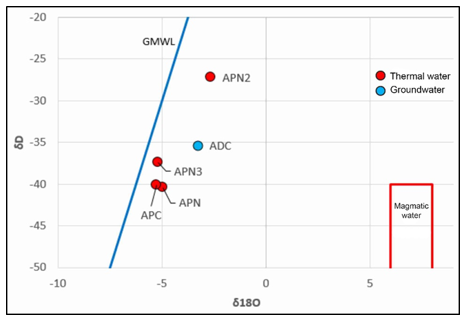Hydrogeochemistry of Natar and Cisarua Hot springs in South Lampung, Indonesia
DOI:
https://doi.org/10.25299/jgeet.2019.4.3.4070Keywords:
geochemistry, hot spring, Natar, Cisarua, Lampung, isotope, geothermometerAbstract
Natar Hot Spring is one of the geothermal manifestations that is located in Lampung Province, Indonesia. About 6 km to the east, another hot spring appears with temperature around 40°C with neutral pH called Cisarua Hot Spring. The Natar Hot Spring itself having temperature 47-54°C with 6.23 pH. Based on the geologic map, the appearance of these hot spring is caused by Lampung-Panjang Fault which trending northwest-southeast. Morphology of the research area is showing a flat terrain topography which composed of Quaternary volcanic rock and metamorphic rock in the basement. The nearest volcano that expected to be the heat source of the geothermal system is the Quaternary extinct volcano called Mt. Betung which is located about 15 km to the southwest. The aim of the study is to analyze the geochemistry of the manifestations and calculate the reservoir temperature. Geochemistry analysis result shows both manifestations are bicarbonate which is formed as a steam-heated water or steam condensates. Geothermometer calculation shows that the geothermal reservoir has temperature 150-160°C with approximately 300 m in depth. All manifestations are originated from meteoric water according to stable isotope analysis D and δ18O data and interacting with carbonate-metamorphic rock beneath the surface based on 13C isotope value. A further geophysics study is needed to determine where the heat comes from.
Downloads
References
Craig, H., 1961. Isotopic Variations in Meteoric Waters. Science 133, 1702–1703. https://doi.org/10.1126/science.133.3465.1702
Fournier, R.O., 1979. A Revised Equation for the NA/K Geothermometer. US Geol. Surv. 3.
Fournier, R.O., Truesdell, A.H., 1973. An empirical Na-K-Ca geothermometer for natural waters. Geochim. Cosmochim. Acta 37, 1255–1275. https://doi.org/10.1016/0016-7037(73)90060-4
Giggenbach, W.F., 1988. Geothermal solute equilibria. Derivation of Na-K-Mg-Ca geoindicators. Geochim. Cosmochim. Acta 52, 2749–2765. https://doi.org/10.1016/0016-7037(88)90143-3
Girianna, M., 2014. Geothermal Handbook for Indonesia. BAPPENAS, Jakarta.
Hochstein, M.P., Sudarman, S., 2008. History of geothermal exploration in Indonesia from 1970 to 2000. Geothermics, Indonesian geothermal prospects and developments 37, 220–266. https://doi.org/10.1016/j.geothermics.2008.01.001
Iqbal, M., Ashuri, W., Juliarka, B.R., Farishi, B.A., Harbowo, D.G., 2018. Delineation of Recharge and Discharge Area for Geothermal Energy in Natar. Presented at the International Conference on Science, Infrastructure Technology, and Regional Development, South Lampung.
Iqbal, M., Herdianita, N.R., Risdianto, D., 2016. Characteristic of geothermal fluid at East Manggarai, Flores, East Nusa Tenggara. IOP Conf. Ser. Earth Environ. Sci. 42, 012016. https://doi.org/10.1088/1755-1315/42/1/012016
Mangga, S.A., Amirudin, Suwarti, T., Gafoer, S., Sidarto, 1993. Peta Geologi Lembar Tanjungkarang, Sumatera skala 1:250.000.
Miljević, N., Boreli-Zdravković, D., Veličković, J., Golobočanin, D., Mayer, B., 2013. Evaluation of the origin of sulphate at the groundwater source Ključ, Serbia. Isotopes Environ. Health Stud. 49, 62–72. https://doi.org/10.1080/10256016.2013.729509
Nicholson, K., 1993. Geothermal Fluids. Springer Berlin Heidelberg, Berlin, Heidelberg.
Nieva, D., Nieva, R., 1987. Developments in geothermal energy in Mexico—part twelve. A cationic geothermometer for prospecting of geothermal resources. Heat Recovery Syst. CHP 7, 243–258. https://doi.org/10.1016/0890-4332(87)90138-4
Pujiindiyati, R., 2007. Tritium (3H) untuk identifikasi dan penanggalan air tanah modern. J. Teknol. Pengelolaan Limbah 10.
Suharno, Aritonang, R.B., Zainudin, A., Rustadi, 2012. Sistem Panas Bumi Cisarua Natar, Lampung Selatan. Presented at the The 12TH ANNUAL INDONESIAN GEOTHERMAL ASSOCIATION MEETING & CONFERENCE, Bandung.
Tonani, F.B., 1980. Some Remarks on the Application of Geochemical Techniques in geothermal exploration, in: Strub, A.S., Ungemach, P. (Eds.), Advances in European Geothermal Research. Springer Netherlands, pp. 428–443.
Truesdell, A.H., 1975. Summary of Section III: Geochemical Techniques in Exploration, in: Second United Nations Symposium on the Development and Use of Geothermal Resources. Lawrence Berkeley Laboratory, Berkeley, California.
White, D.E., 1974. Diverse Origins of Hydrothermal Ore Fluids. Econ. Geol. 69, 954–973. https://doi.org/10.2113/gsecongeo.69.6.954

Downloads
Published
Issue
Section
License
Copyright @2019. This is an open-access article distributed under the terms of the Creative Commons Attribution-ShareAlike 4.0 International License which permits unrestricted use, distribution, and reproduction in any medium. Copyrights of all materials published in JGEET are freely available without charge to users or / institution. Users are allowed to read, download, copy, distribute, search, or link to full-text articles in this journal without asking by giving appropriate credit, provide a link to the license, and indicate if changes were made. All of the remix, transform, or build upon the material must distribute the contributions under the same license as the original.










